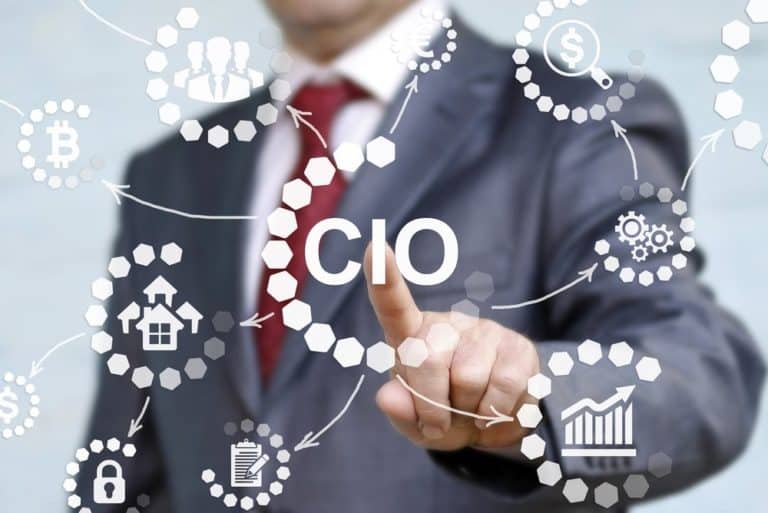The CIO of the future is increasingly at the forefront of the organisation. By combining technical and business expertise, the CIO (Chief Information Officer) of the future is the driver of growth and innovation, and leads the transformation of the organisation.
The C-suite changes: CIO, CDO, CTO, CSO
As demand from the business changes, technical roles within the organisation change and roles arise that did not exist a few years ago. Roles such as CTO or CSO emerge because IT is becoming increasingly complex. There are also roles that are no longer purely technical but focus on the change process, such as the CDO.
The CDO supports strategic business objectives and generates important insights about the customer. At the same time, it is also close to the IT department. “At a certain point you no longer talk about business or technology, but about change projects with a digital perspective,” says Elke Laeremans, the CDO of Torfs.

How does the CIO of the future drive the customer journey?
Digital aspects are becoming increasingly important in the entire customer journey. But who is actually in charge of the customer experience? CIO’s still often think that designing a website and deciding on the features that come with it is something that is strictly determined by marketing or the business.
As soon as the business decides what they want, IT will develop and support it. This often seems to be the most efficient way of working, because IT can then focus on other things. Yet companies where IT and marketing work together at an earlier stage, such as Google, Facebook and Airbnb, are more successful than companies where these two departments only communicate later.
Increasingly, organisations will expect their CIO to be able to transform business processes, such as the customer journey. Of course, he or she must be able to build back-end systems, but the CIO will also have to streamline business processes by means of technology.
Which technology can be deployed?
1. Smart chatbots
To give an example: smart chatbots based on AI and machine learning, such as KLM’s Blue Bot, can better understand and respond to the customer. Simple, recurring questions are quickly picked up and answered by the bot, and personal questions that require more attention are forwarded directly to the right service employee. Like that, the customer is helped quickly and personally.
2. IoT and real-time technologies
Another example comes from Trailblazer KONE, where IoT and real-time technologies make their escalators, elevators and moving walkways smarter. The system can detect malfunctions and automatically issue a work order, making it possible to fix the problem before the customer even notices that something is wrong.
In addition, field workers have access to good and up-to-date information, and these insights also enable them to respond better to the customer’s needs. This allows a company to proactively provide better service, improving customer experience, resulting in more satisfied customers.
The ultimate customer journey
The ultimate customer journey is based on deep and broad customer insights. Each department within an organisation collects their own data and forms their own insights about customers. The problem, however, is that without a customer data platform, this data is fragmented and cannot be fully utilised.
When systems and data sources do not work together, one department cannot access the valuable insights of another; insights that can help to serve the customer even better. As a result, there is no uniform customer view.
It is up to the CIO to integrate all different data sources so that each business department has access to all customer information at all times and can offer a better customer experience. For example, this enables a sales rep to identify cross-selling and up-selling opportunities based on each customer’s history.
When all customer data is available, this data can also be analysed, and recommendations can be made. Based on previously purchased products, you can then find out, for example, if and what someone will most likely buy next time. This enables marketing to bring the right message to the right customer at the right time so that he or she converts faster.

More customer data calls for more governance
Now that more and more customer data is becoming available through all kinds of systems, it is highly important for the customer experience that the organisation can demonstrate that it deals well with data, for example by complying with the GDPR legislation.
The CIO has an important task in this respect. With the right governance strategy, the CIO ensures that privacy can be safeguarded and that demand and requirements from other departments, such as legal, can be met. Safeguarding privacy and complying with the rules, for example, is a joint effort by the organisation, with the CIO in the middle, connecting everything.
Having everything in order with the GDPR also has other advantages: the more up-to-date (or ‘cleaner’) the data within the organisation, the better and truthful the analyses are. This enables higher management to make better and more data-driven decisions. In this way, the CIO contributes to creating trust, which is central to the customer journey.
The CIO of the future is indispensable in developing and improving the customer journey. This is a good reason to move the CIO more and more to the forefront of the organisation.

This is a guest contribution submitted by Salesforce. Through this link, you will find more information about the possibilities of the company.
